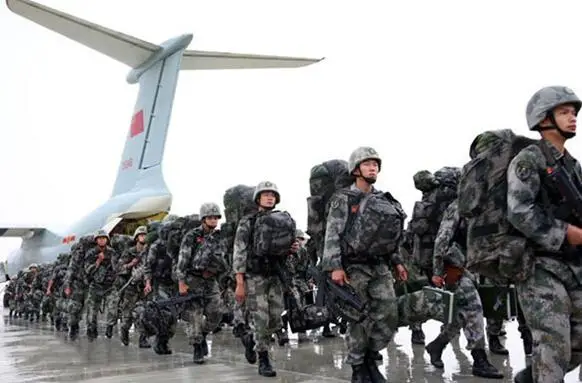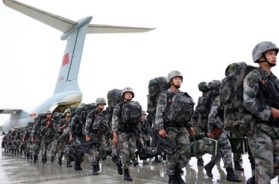Source: People's Daily
It is very clear that Indian border troops’ crossing of the China-India boundary in the Sikkim sector into the Chinese territory is totally illegal, and China will take all necessary measures to safeguard its legitimate and lawful rights and interests, the People’s Daily said in a commentary published under the byline of Zhong Sheng on Friday.
The comments came after China’s Ministry of Foreign Affairs (MFA) published an official document entitled “The Facts and China’s Position Concerning the Indian Border Troops’ Crossing of the China-India Boundary in the Sikkim Sector into the Chinese Territory” on Wednesday, allowing the international community to become better acquainted with the facts of the incident.
Indian border troops are still illegally staying in Chinese territory after they illegally crossed the border into Chinese territory on June 18.
What India did, which can be defined as an illegal act in nature, that aims at nothing but making trouble, the article pointed out.
It is universally recognized that once a boundary is established by a convention, it will come under particular protection by international law, the commentary noted, stressing that the China-India boundary in Sikkim sector is delimited by the 1890 Convention between Great Britain and China Relating to Sikkim and Tibet.
According to the Convention, the Doklam area, which is located on the Chinese side of the boundary, is indisputably Chinese territory, the paper added.
The Convention gives a clear and precise description of the alignment of the boundary in this sector, said the article, and it delineates that the actual boundary on the ground follows the watershed and its alignment is easily identifiable.
India’s unauthorized crossing of such a delimited boundary is very reckless and rude, the paper underlined, pointing out at the same time that what the country did, which goes against the basic principles of international law and basic norms governing international relations, is intolerable for any country.
After the founding of the People’s Republic of China and Indian independence, the governments of both countries inherited the 1890 Convention and the delimited China-India boundary in the Sikkim Sector as established by the Convention.
Each of the two sides has for a long time exercised jurisdiction over its side of the boundary delimited by the 1890 Convention without any dispute over the specific alignment of the boundary, the paper added.
This makes it fundamentally different from past frictions between the border troops of
the two sides in areas where the boundary has not been delimited boundary, the paper said.
This is also why the Chinese side repeated its demands of the immediate and unconditional withdrawal of the trespassing Indian troops back to the Indian side of the boundary, it added, emphasizing that it is also prerequisite and basis for resolving the incident.
The article further refuted the excuses India has invented to justify its illegal actions since the incident broke out.
India’s so-called “security concerns” over China’s road-building activities is clearly ill-founded. If a country takes “security concerns” as an excuse to justify its boundary-crossing and entry into other countries, it is putting world and regional peace at stake, the article pointed out.
“If India insists on this kind of logic, how can it get along peacefully with its neighboring countries?” it questioned.
What’s more, India’s claim that Doklam is a disputed area between China and Bhutan is against the truth and the law, the paper stressed.
“The Doklam area has all along been part of China and under China’s continuous and effective jurisdiction. There is no dispute in this regard,” it underlined, adding that as a third party, India has no right to make territorial claims on Bhutan's behalf.
India’s intrusion into the Chinese territory under the pretext of Bhutan has not only violated China’s territorial sovereignty but also challenged Bhutan’s sovereignty and independence, said the People’s Daily.
The conduct is also a severe violation of the UN Charter and its behavior has formed an international delinquency.
In addition, the rhetoric that India upheld, namely that China and India have been in discussions on making the boundary in the Sikkim Sector an "early harvest" which proves the area is disputed, is a sophistry.
The article admitted that Chinese and Indian sides have been in discussion on making the boundary in the Sikkim Sector an “early harvest” in the settlement of the entire boundary question during the meetings between the Special Representatives on the China-India Boundary Question, but pointed out at the same time that this is mainly in view of a series of considerations.
It explained that the boundary in the Sikkim Sector has long been delimited by the 1890 Convention, which was signed between then China and Great Britain. China and India ought to sign a new boundary convention in their own names to replace the 1890 Convention.
This, however, in no way alters the nature of the boundary in the Sikkim Sector as having already been delimited and should not be used as India’s excuse for illegal trespass, the article continued.
The stability and inviolability of boundaries is a fundamental principle enshrined in international law, it further pointed out.
It is clear and definite that India’s crossing is illegal, the article emphasized. Since the incident occurred, China has sought to communicate with India through diplomatic channels to resolve the incident. But no country should ever underestimate the resolve of the Chinese government and people to defend China's territorial sovereignty, the commentary stressed.
China will take all necessary measures to safeguard its legitimate and lawful rights and interests, it concluded.
The comments came after China’s Ministry of Foreign Affairs (MFA) published an official document entitled “The Facts and China’s Position Concerning the Indian Border Troops’ Crossing of the China-India Boundary in the Sikkim Sector into the Chinese Territory” on Wednesday, allowing the international community to become better acquainted with the facts of the incident.
Indian border troops are still illegally staying in Chinese territory after they illegally crossed the border into Chinese territory on June 18.
What India did, which can be defined as an illegal act in nature, that aims at nothing but making trouble, the article pointed out.
It is universally recognized that once a boundary is established by a convention, it will come under particular protection by international law, the commentary noted, stressing that the China-India boundary in Sikkim sector is delimited by the 1890 Convention between Great Britain and China Relating to Sikkim and Tibet.
According to the Convention, the Doklam area, which is located on the Chinese side of the boundary, is indisputably Chinese territory, the paper added.
The Convention gives a clear and precise description of the alignment of the boundary in this sector, said the article, and it delineates that the actual boundary on the ground follows the watershed and its alignment is easily identifiable.
India’s unauthorized crossing of such a delimited boundary is very reckless and rude, the paper underlined, pointing out at the same time that what the country did, which goes against the basic principles of international law and basic norms governing international relations, is intolerable for any country.
After the founding of the People’s Republic of China and Indian independence, the governments of both countries inherited the 1890 Convention and the delimited China-India boundary in the Sikkim Sector as established by the Convention.
Each of the two sides has for a long time exercised jurisdiction over its side of the boundary delimited by the 1890 Convention without any dispute over the specific alignment of the boundary, the paper added.
This makes it fundamentally different from past frictions between the border troops of
the two sides in areas where the boundary has not been delimited boundary, the paper said.
This is also why the Chinese side repeated its demands of the immediate and unconditional withdrawal of the trespassing Indian troops back to the Indian side of the boundary, it added, emphasizing that it is also prerequisite and basis for resolving the incident.
The article further refuted the excuses India has invented to justify its illegal actions since the incident broke out.
India’s so-called “security concerns” over China’s road-building activities is clearly ill-founded. If a country takes “security concerns” as an excuse to justify its boundary-crossing and entry into other countries, it is putting world and regional peace at stake, the article pointed out.
“If India insists on this kind of logic, how can it get along peacefully with its neighboring countries?” it questioned.
What’s more, India’s claim that Doklam is a disputed area between China and Bhutan is against the truth and the law, the paper stressed.
“The Doklam area has all along been part of China and under China’s continuous and effective jurisdiction. There is no dispute in this regard,” it underlined, adding that as a third party, India has no right to make territorial claims on Bhutan's behalf.
India’s intrusion into the Chinese territory under the pretext of Bhutan has not only violated China’s territorial sovereignty but also challenged Bhutan’s sovereignty and independence, said the People’s Daily.
The conduct is also a severe violation of the UN Charter and its behavior has formed an international delinquency.
In addition, the rhetoric that India upheld, namely that China and India have been in discussions on making the boundary in the Sikkim Sector an "early harvest" which proves the area is disputed, is a sophistry.
The article admitted that Chinese and Indian sides have been in discussion on making the boundary in the Sikkim Sector an “early harvest” in the settlement of the entire boundary question during the meetings between the Special Representatives on the China-India Boundary Question, but pointed out at the same time that this is mainly in view of a series of considerations.
It explained that the boundary in the Sikkim Sector has long been delimited by the 1890 Convention, which was signed between then China and Great Britain. China and India ought to sign a new boundary convention in their own names to replace the 1890 Convention.
This, however, in no way alters the nature of the boundary in the Sikkim Sector as having already been delimited and should not be used as India’s excuse for illegal trespass, the article continued.
The stability and inviolability of boundaries is a fundamental principle enshrined in international law, it further pointed out.
It is clear and definite that India’s crossing is illegal, the article emphasized. Since the incident occurred, China has sought to communicate with India through diplomatic channels to resolve the incident. But no country should ever underestimate the resolve of the Chinese government and people to defend China's territorial sovereignty, the commentary stressed.
China will take all necessary measures to safeguard its legitimate and lawful rights and interests, it concluded.
 Menu
Menu
 China’s resolve to defend its territorial sovereignty should not be underestimated: People’s Daily
China’s resolve to defend its territorial sovereignty should not be underestimated: People’s Daily

















